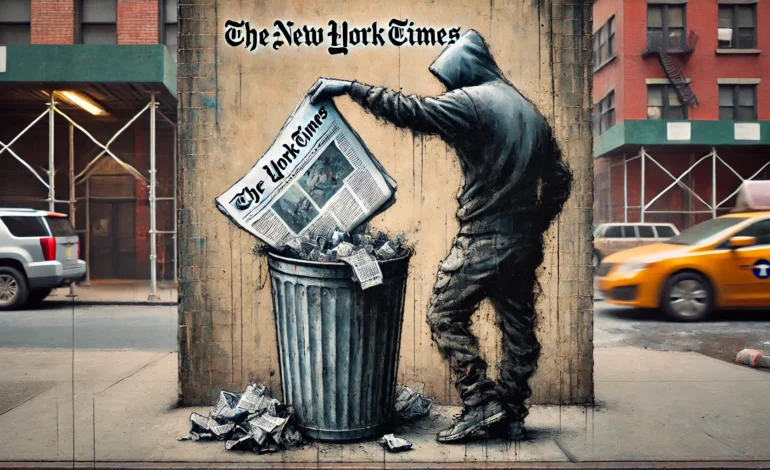Why I’m no longer a fan of nyt Times: A Comprehensive Analysis

No longer a fan of NYT, I have watched as the once-revered institution in American journalism has undergone significant changes that have left many readers, myself included, questioning its reliability. Known historically for its balanced news coverage and in-depth investigative reporting, the NYT has, over the years, shifted in ways that have sparked dissatisfaction among its once-loyal readership. This article explores the key reasons behind the growing criticism of the NYT and why it is no longer considered a go-to source for dependable journalism.
Shift Toward Sensationalism
One of the most significant changes in the NYT’s editorial direction is its increased focus on sensationalism. The rise of digital media and the need to capture clicks and engagement have pushed the newspaper toward using more attention-grabbing headlines and shorter articles. This shift is evident in the prevalence of clickbait-style headlines, which prioritize immediate reader attention rather than providing thorough, investigative content.
In the digital age, news outlets are competing for online traffic, and the NYT has not been immune to this pressure. However, the pursuit of clicks has led to a decline in the depth and rigor of its journalism, resulting in a less satisfying experience for readers who expect more from a newspaper of its stature.
Perceived Editorial Bias
Another key factor contributing to the decline in reader trust is the perceived bias in NYT’s reporting. While bias in media is not a new phenomenon, many readers feel that the NYT has increasingly allowed its content to be shaped by particular ideological perspectives. Political coverage, in particular, has been criticized for presenting a slanted view of events, with articles that should be neutral often coming across as opinionated.
This shift has sparked concerns about the paper’s commitment to impartial journalism. Many readers have observed that stories are sometimes framed in a way that reinforces certain narratives, leading to a perception that the NYT is more interested in shaping public opinion than providing balanced news.
Decline in In-Depth Reporting
Once known for its long-form investigative pieces, the NYT has, over time, shifted toward publishing more frequent but shorter articles. The 24-hour news cycle and the pressure to release stories quickly have contributed to this trend. As a result, readers have noticed a reduction in the quality and thoroughness of its content. Investigative journalism, a hallmark of the NYT’s reputation, has become less frequent, replaced by brief, surface-level articles.
This move toward quantity over quality has disappointed readers who relied on the NYT for its comprehensive coverage of complex issues.
Rising Subscription Costs
The NYT’s digital-first strategy has also led to increased subscription costs, which has become a growing concern for many readers. The implementation of a paywall has restricted access to most of the newspaper’s content, and the rising fees make it increasingly difficult for readers to justify maintaining their subscriptions. For those who cannot afford the high cost, the barrier to accessing quality journalism is significant, especially when free or lower-cost alternatives are available.
The Influence of Social Media
The role of social media in shaping the NYT’s content cannot be ignored. With the rise of platforms like Twitter and Facebook, the pressure on news outlets to produce shareable and viral content has intensified. The NYT has adapted to this environment by publishing articles that cater to social media trends, which has, in some cases, come at the expense of journalistic integrity.
The drive to produce content that performs well on social media has led to shorter, less thoroughly researched articles. For readers who value in-depth analysis and balanced reporting, this trend is particularly concerning.
Moving Forward: Seeking Alternatives
As a result of these changes, many readers, myself included, have started seeking alternative sources of news. Publications like The Washington Post and The Guardian continue to provide balanced, in-depth reporting without relying heavily on sensationalism. Additionally, independent journalism platforms such as ProPublica and The Intercept have gained popularity for their commitment to investigative reporting.
For those who are disillusioned with the NYT’s current direction, exploring a variety of news sources can provide a more well-rounded and reliable perspective on current events.
Conclusion
In conclusion, the reasons behind the growing disillusionment with The New York Times are multifaceted. From the rise of sensationalism and perceived bias to the decline in investigative journalism and rising subscription costs, these factors have contributed to the erosion of trust among loyal readers. While the NYT remains a significant player in the media landscape, it is crucial for readers to critically assess the content they consume and seek out news sources that align with their expectations for journalistic integrity.
By remaining vigilant and exploring a range of news outlets, readers can ensure they are receiving balanced, reliable information in an increasingly fragmented media landscape.






